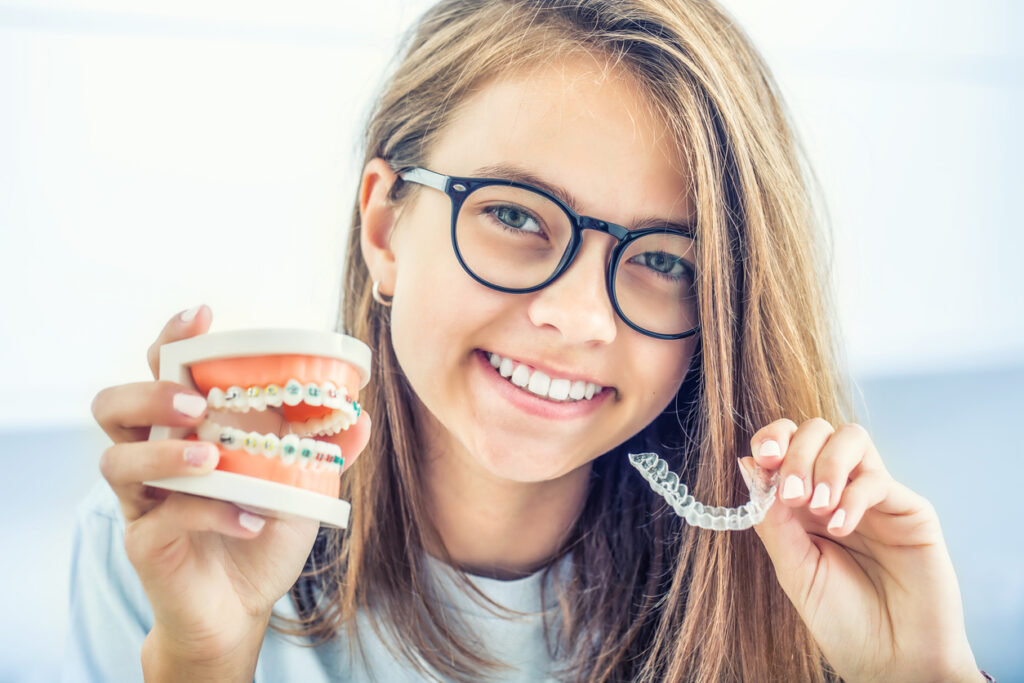How are they similar?
Braces and Invisalign treatments are similar in many ways, even though they look and feel different. Both must be worn all day, but Invisalign trays are removed when brushing your teeth and eating. Both require a commitment to following instructions for wear, cleaning, and oral health.
Invisalign and braces are effective treatments for correcting crooked teeth, overbites, underbites, and jaw positions. The average braces or Invisalign treatment time is similar at about 18 months.
How are they different?
The main difference between braces and Invisalign is the technique used to shift teeth and create a beautiful smile.
Braces use metal or clear brackets and high-tech wires inside the mouth during treatment to change the teeth’s positioning. Elastics are often used in this process to bring teeth into alignment.
Invisalign uses a series of clear custom aligning trays to move teeth, and aligners are changed every one to two weeks. Invisalign is a very aesthetic solution to align your teeth but requires a lot of patient compliance and dedication.
Benefits of braces
It’s best to consider a list of what makes braces a good option depending on your case.
- Irremovable: Metal or clear ceramic braces will stay in place, which is good for patients who are worried about losing the removable clear Invisalign aligner trays, don’t want to have to remove Invisalign trays prior to eating, or who feel they would not be compliant with wearing Invisalign trays for 22 hours per day.
- Treatment time: Because braces are irremovable, the treatment time can be more predictable and in some cases shorter compared to Invisalign depending on what the patient needs. Braces are glued on to the patient’s teeth so are on the teeth 24 hours a day, seven days a week. Treatment time can range from six to 24 months and is dependent on how much teeth movement is required. There is also less temptation to take the braces off if they can’t be removed, which is good for patients who lack self-discipline.
- Cleaning: Maintaining good oral hygiene with braces will require more time and effort compared to cleaning your teeth while in Invisalign. The braces and orthodontic wires will create more nooks and crannies that food can become stuck in. Severe gum inflammation and bleeding can occur if proper flossing and brushing are not done while in braces.
- Follow-up visits: While in braces, Dr. Gupta will want to see you about every two months to have your braces adjusted. These appointments are approximately 20 to 30 minutes long.
- Cost: The price of braces depends on the complexity of the case but is similar to the cost of Invisalign.
- After care: Once we have perfected your smile and your braces are removed, it will be important to maintain the final result. To keep your teeth from shifting back, we will give you a custom-made retainer (similar to an Invisalign tray) that you will wear just to bed. We will also give you the option of having a permanent retainer placed behind your front teeth that will also help keep your teeth aligned.
- Effectiveness: The effectiveness of braces is largely dependent on the skill level of the orthodontist and the willingness of the patient to comply with instructions (brushing, flossing, wearing elastics, etc.) and consistently coming in for adjustment appointments.
Challenges of braces
- Braces are visible and not as aesthetic or comfortable as Invisalign.
- Flossing and brushing may require more effort.
- Certain food and drink must be avoided (hard/sticky foods).
- Mouthguards are recommended to protect the mouth during athletics.
- Braces can become unglued between appointments requiring an unscheduled visit to the orthodontist.
Benefits of Invisalign
- Removable: One of the biggest benefits to having Invisalign as a treatment option is that the trays can be removed, allowing you to eat and drink without any food restrictions.
- Appearance: Most patients tend to prefer Invisalign because the trays are clear. This can be great for adults who have wanted to straighten their teeth for a while, but have hesitated due to the appearance of having braces at an older age. Invisalign is also a popular option for older teens that don’t want braces while in high school. With Invisalign, many people may not even notice when a patient is wearing them.
- Comfort: Invisalign treatment is typically more comfortable compared to braces since there are no brackets that can create sores in your mouth or wires that can poke.
- Treatment time: Invisalign trays need to be worn about 22 hours a day (only being removed for eating and brushing). If the patient is able to be compliant with consistently wearing the trays, then treatment time is typically the same as braces.
- Cost: The price of Invisalign depends on the complexity of the case but is similar to the cost of braces in most cases.
- Cleaning: You can clean Invisalign trays with an Invisalign cleaning system, or by brushing and rinsing the trays in lukewarm water. This should be done after you eat or drink anything besides water, and at morning and night.
- Follow-up visits: A big advantages of Invisalign is that we are able to see you for follow up visits less often (typically every two to three months) and your appointments are usually 20 minutes or less.
Challenges of Invisalign
- Compliance of wearing trays 22 hours per day is vital to a successful treatment outcome.
- Patient needs to be responsible with trays and not misplace them.
- Trays may stain if not removed before eating and drinking.
